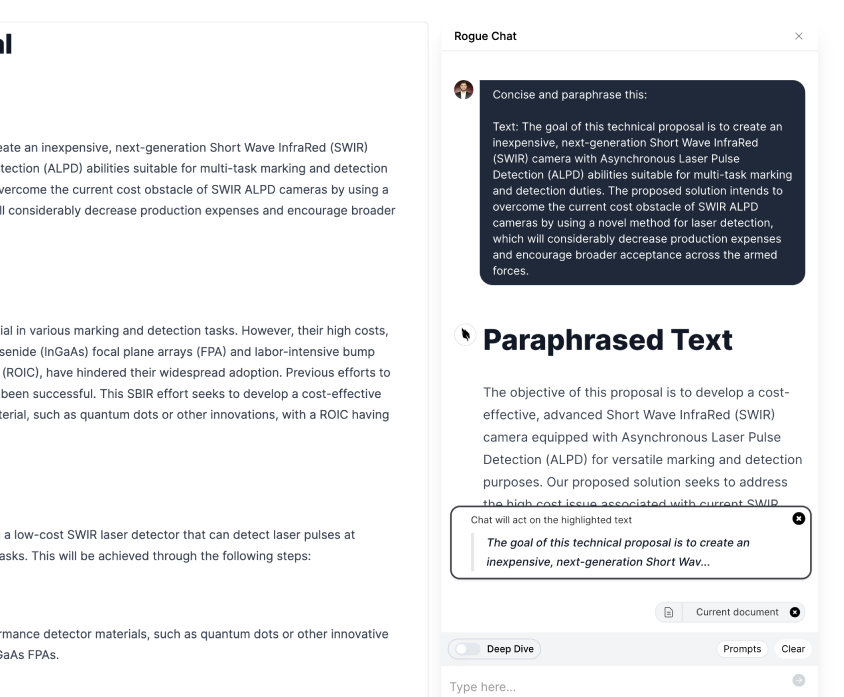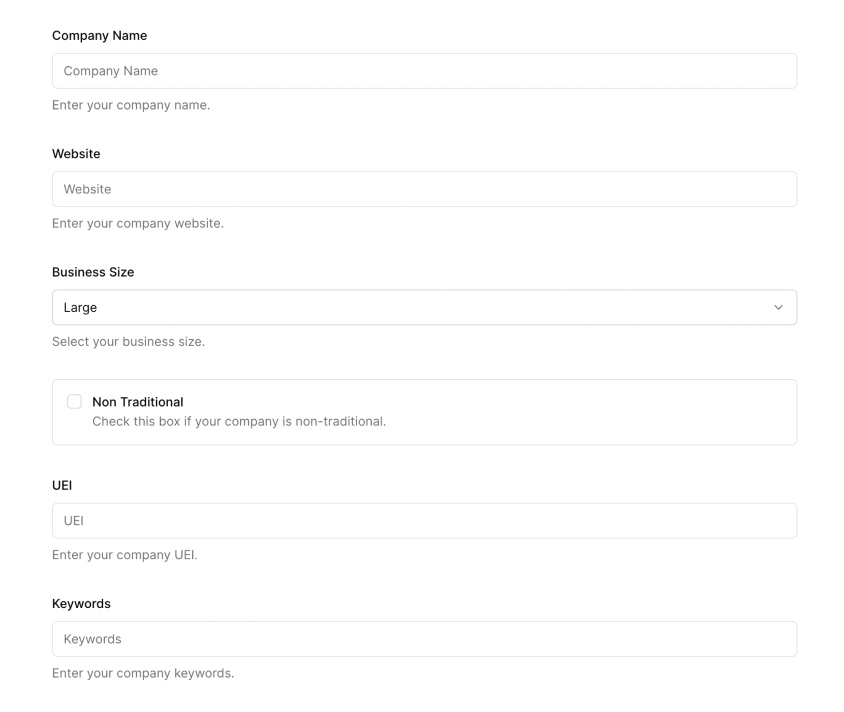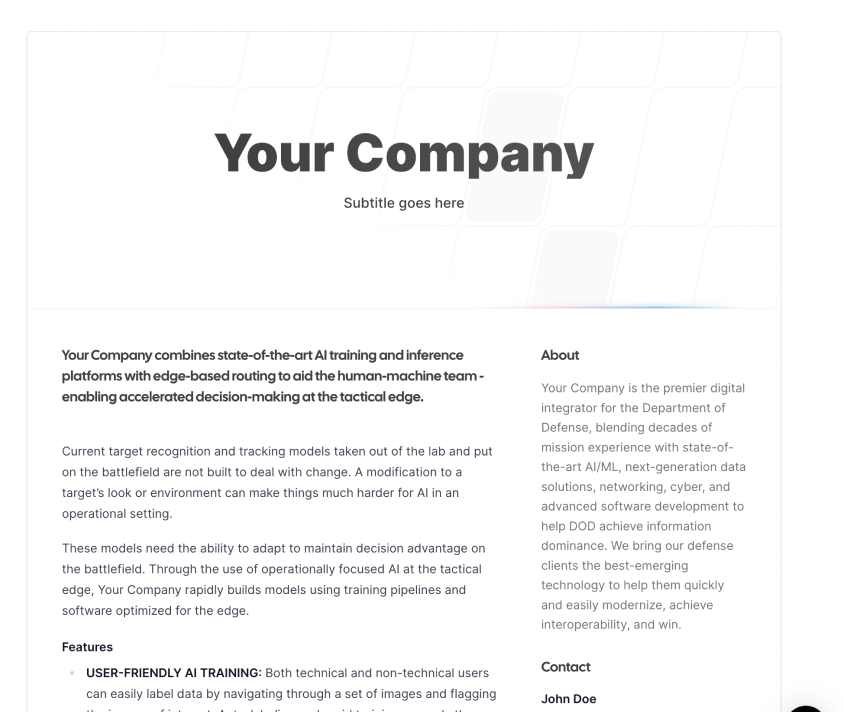
2.0 The Valley of Death
Where is this valley, and why is it full of dead unicorns?
What About the Valley of Death?
The valley of death is the chasm of technology transition from S&T/R&D organizations and the acquisition organizations they are built to serve.
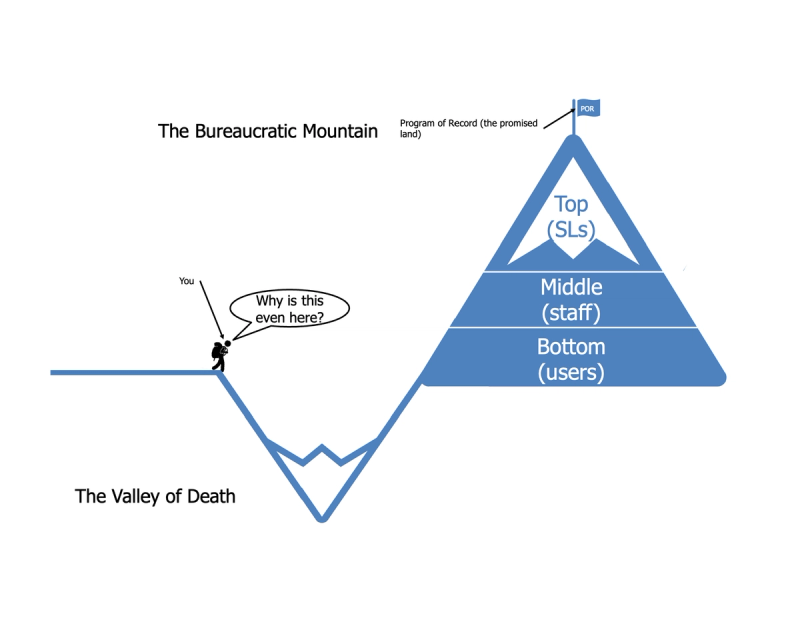
Why does the valley of death exist? That's a big question with many answers, the central answer is the process.
If you haven't looked at "The Chart" you may not be familiar with the Joint Capabilities Integration and Development System (JCIDS), that's ok, it'll take you hours and hours to wrap your head around it.
The bottom line goes like this:
Every 4 years there's a national security strategy.
From that comes the national defense strategy
From that comes an assessment of how well the DoD will meet the specified strategy.
From that the military Services determine what they need to build and buy.
From that, the RDT&E shops are supposed to do research to deliver the future capabilities needed.
From those, the acquisition program managers are supposed to pluck the tech they need to achieve the strategy.
Problem is, that takes forever, and everyone is impatient to be more technologically advanced NOW.
So there's a ton of bootstrapped R&D programs out there investing in emergent tech.
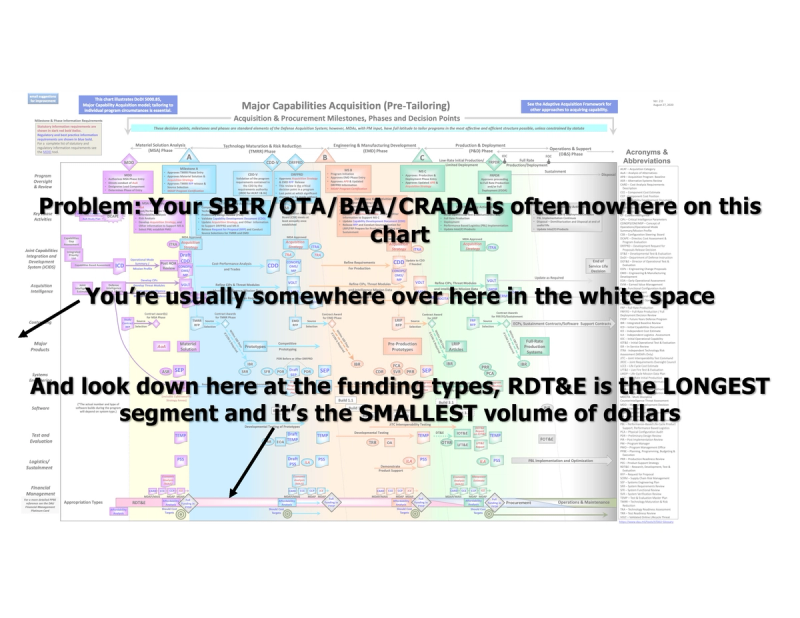
Sure, there's the Adaptive Acquisition Framework where you can shortcut the long process, let me know if that works for you. Chances are, if you're reading this, you've experienced the reality of things taking really long because of the legacy process that everyone is trying to bootstrap around.
Mind you, there are plenty of R&D shops that make a decent living by winning DARPA contracts and building tech they have no intention to productize.
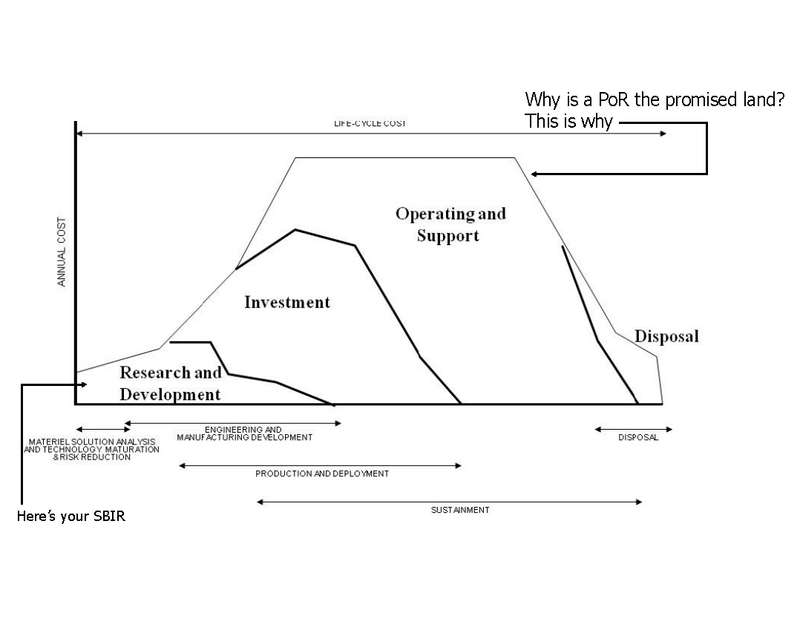
However, if you're a startup, you and your investors are looking for a big exit, so you want to get the big dollars from Procurement (PROC) and Operations and Maintenance (O&M), and those come from a program of record.
So, again, why is there a valley of death???
Money is AN ANSWER. There are different "colors of money", the one that funds all the development and experimentation is RDT&E.
And there are different "Budget Activities", some fund for fundamental research, others fund prototype maturation. Different organizations have different pots of RDT&E, for instance, DARPA doesn't have BA 4 and 5, SOCOM S&T does, so not all S&T orgs are the same.
In general though, the folks who spend RDT&E are different from hose who spend PROC and O&M.
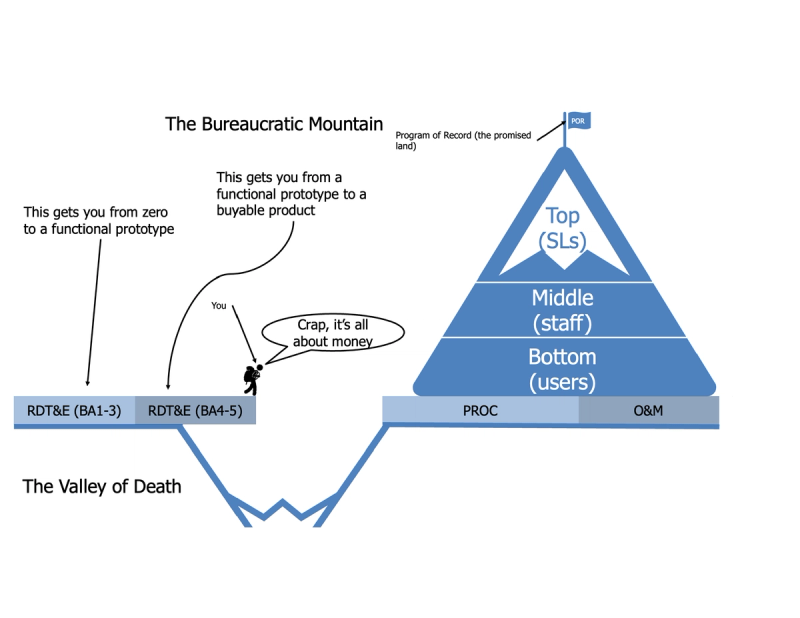
The real challenge is that these folks don't communicate or collaborate very well. Bottom line.
It's not their fault necessarily, they each have jobs to do and they are very different.
R&D Program Managers need to be out there doing cutting edge science stuff, finding the next big thing, managing and buying down technical risk, proving the realm of the possible.
Acquisition Program Mangers need to be out there fielding capabilities, making sure they get the right number of units out of a producer, make sure they get delivered to the right place at the right time.
R&D Program Managers only really need to talk to Acquisition Program Managers when they have a new things that's actually going to work, which is not all the time.
Acquisition Program Managers really only need to talk to R&D Program Managers when the things they're fielding are no longer sufficient for the force, which is not all the time.
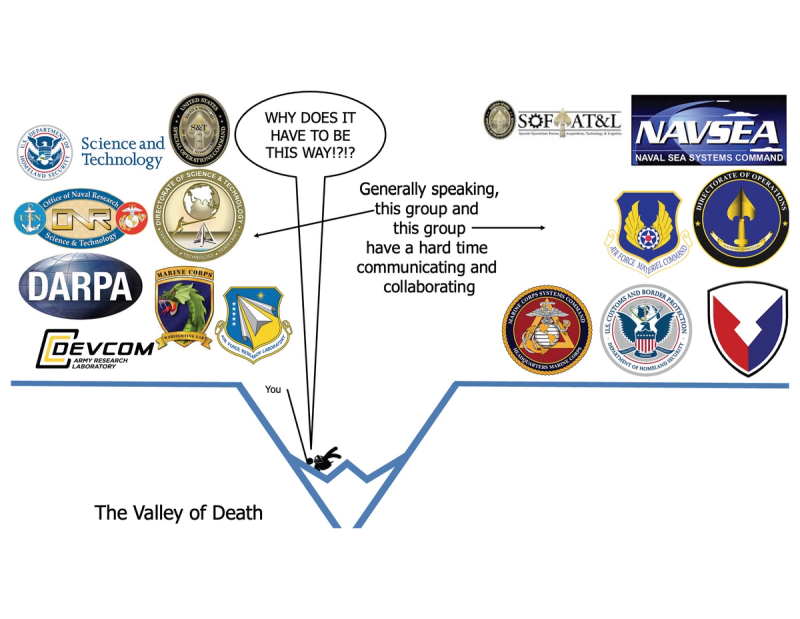
So what do you do about it? You gotta build the bridge, like it or not that's how you win. Let's talk about that.
Bridging the Valley of Death
Step 1: Spot Your Landing
The valley of death is wide and full of unicorns like yours, but it’s wider in some spots than others, and it’s infinitely wide if you’re not looking for the other side of the chasm. To put it plainly, if you’re not sure what you’re really selling, who wants it or needs it, or worse you try selling to the wrong person, then you’re going to fail.
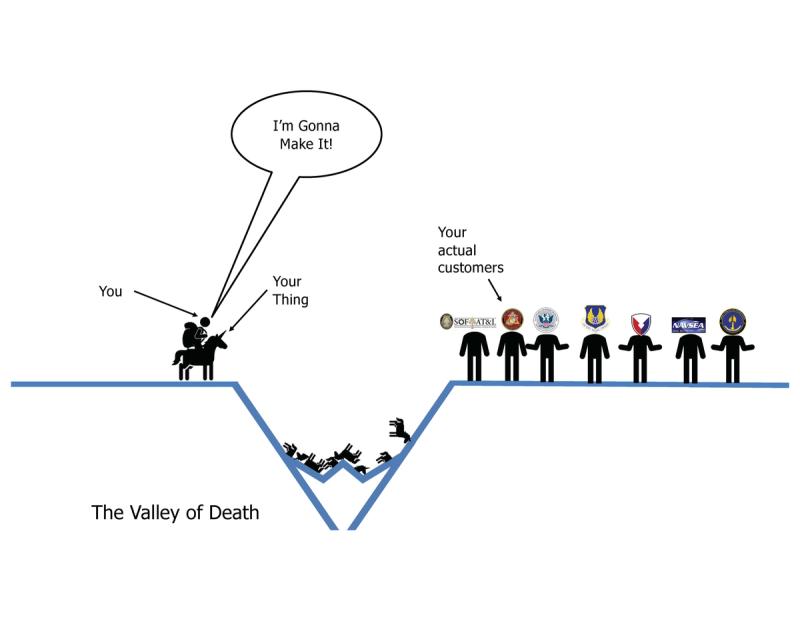
So let’s start with the super simple business question, what are you making?
To be clear, you need to answer this question two ways:
- That is the category of the thing (communications, lethality, mobility, jammers, jets, rocket ships, whatever).
- The capability of your thing (what value does it add to the user).
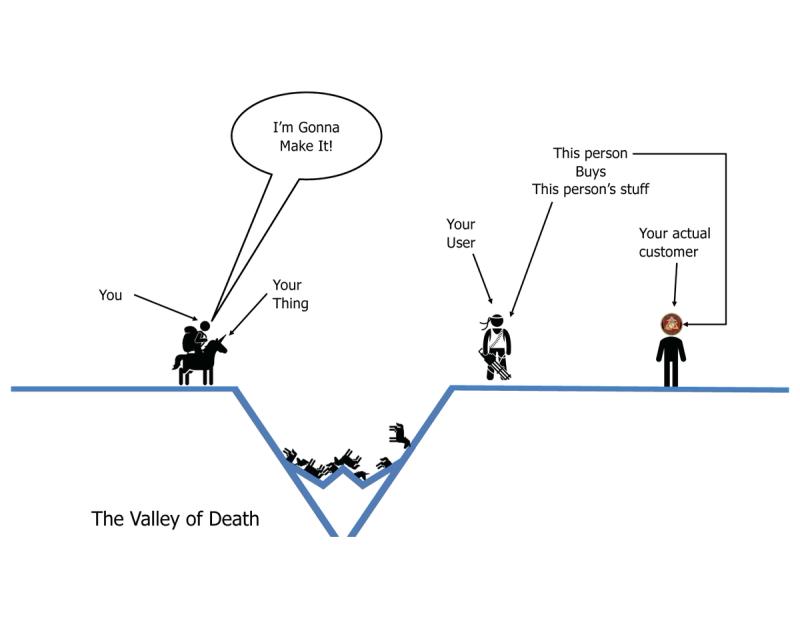
Why do we differentiate this?
Well, #1 is for the PM’s (your actual customers), and number #2 is for the users.
While you're at it, you might ask yourself why are you making it? Like, what was your starting thesis, what made you say “someone needs this thing”? To me this sounds like a silly question, but objectively I know there’s a lot of solutions out there looking for problems.
Bottom line, end-users don't buy things, acquisition program managers do. So you can talk to users until you're blue in the face, but if you don't get in contact with a PM, you're probably going to have a bad time.
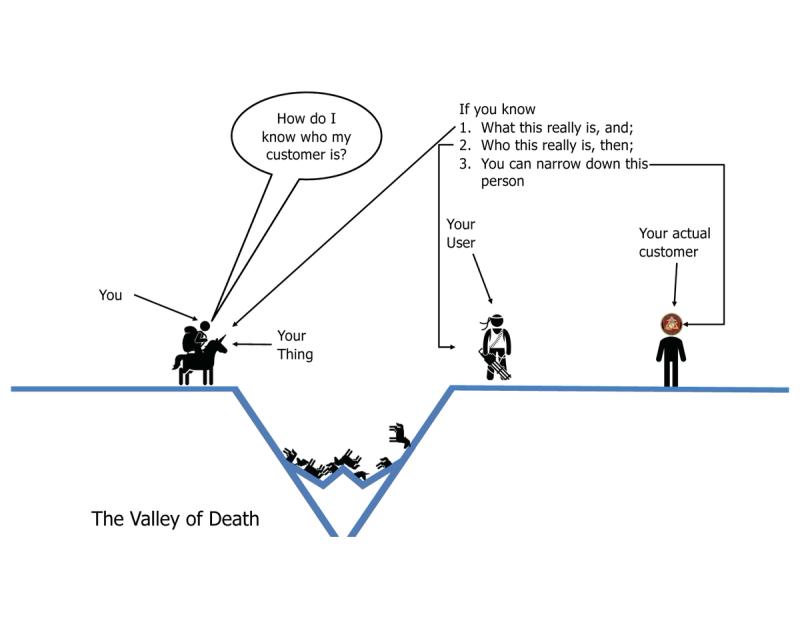
BUT! you do need to START with the end users, because that plus what you're building will determine which PM to contact.
So lets talk about end users...
Who (do you think) needs what you're making, and what makes you think they need it? In terms of military use case putting it in terms of:
There is a current/pending threat <x>, and without my thing more U.S. personnel will be casualties of the next/current conflict
There is a current/pending threat <x>, and without my thing fewer enemy personnel will be casualties of the next/current conflict
Worth noting: the latter is almost always more compelling than the former, firepower always sells better than forcepro, and training sells worst of all. Ironically there’s often a pile of training money left over at the end of the fiscal year but it seldom goes towards technology investment, it’s a whole color of money thing, just take my word for it.
How many of those people are there, really? Not how many COULD there be, how many ARE there, right now. (This is your TAM btw)
Stuff gets “issued” based on an established force structure, if someone doesn’t need/use/have a thing like your thing right now then:
you might sell some of them as a one-off
b. it’ll typically take 24 months to get a forcemod approved
The only major caveat is whether there’s a current war/conflict/foreign assistance effort for which your thing is relevant, but that’s not a long-term win
Who else makes a thing like your thing?
If it’s no one, that could be awesome, total green field, but it’s also an indicator - there might be a reason
What does your thing do? Not technically, but operationally
How is it better/faster/cheaper than status quo for military operations? How does it support the NSS/NDS? How does it support the commander’s strategy for whomever your customers are?
Word to the wise: don’t build tech for the last war.
Seriously, avoid the following tech if you can help it: counter-IED, anything to do with door kicking and direct action, stuff that’s hyper niche to Special Operations, fixed-wing ISR. Just a suggestion. If you don’t know what problems you should tackle, look up some strategy documents like “Army 2035”.
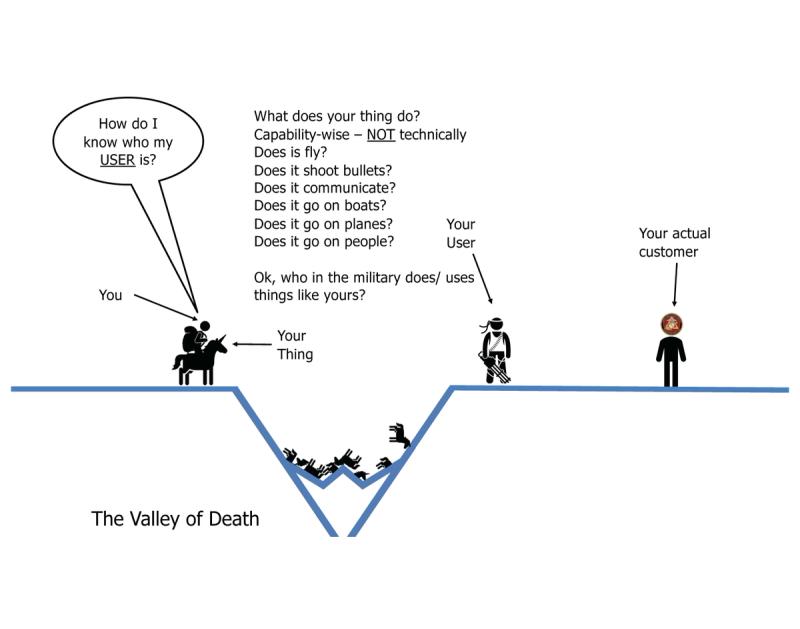
Why all this focus? Because what you’re building and for whom you’re building it determines who foots the bill, bottom line. If you cant answer the above question then you cant figure out the answer to this golden question.

Who are these mythical PMs, its pretty simple actually.
Army
JOINT PROGRAM EXECUTIVE OFFICE ARMAMENTS & AMMUNITION
JPEO Armaments & Ammunition leads the development, procurement, and delivery of lethal armaments and ammunition providing joint warfighters with overmatch capabilities to defeat current and future threats. https://jpeoaa.army.mil/jpeoaa/
JOINT PROGRAM EXECUTIVE OFFICE CHEMICAL, BIOLOGICAL, RADIOLOGICAL AND NUCLEAR DEFENSE
JPEO-CBRND is the Joint Service’s lead for the development, acquisition, fielding, and life cycle support of CBRN defense equipment and medical countermeasures. https://www.jpeocbrnd.osd.mil/
PROGRAM EXECUTIVE OFFICE ASSEMBLED CHEMICAL WEAPONS ALTERNATIVES
PEO ACWA is responsible for the safe destruction of the remaining U.S. chemical weapons stockpile in Colorado and Kentucky. https://www.peoacwa.army.mil/
PROGRAM EXECUTIVE OFFICE AVIATION
PEO Aviation supports Army commanders by delivering capabilities to the Combat Aviation Brigade. The organization supports Army Readiness by leading and executing life cycle management for all Army aviation weapons systems. https://www.army.mil/PEOAviation
PROGRAM EXECUTIVE OFFICE COMBAT SUPPORT AND COMBAT SERVICE SUPPORT
PEO CS&CSS is responsible for the life cycle of approximately 20% of the Army’s total equipment programs spanning the Engineer, Ordnance, Quartermaster, and Transportation portfolios. https://www.peocscss.army.mil/
PROGRAM EXECUTIVE OFFICE COMMAND, CONTROL, COMMUNICATIONS-TACTICAL
PEO C3T is supporting the Army’s new network modernization by delivering a tactical network designed to integrate unified network transport, deliver a common operating environment, enable Joint and coalition interoperability, and develop more mobile and expeditionary command posts. https://peoc3t.army.mil/c3t/
PROGRAM EXECUTIVE OFFICE ENTERPRISE INFORMATION SYSTEMS
PEO EIS provides and manages the information technology network and day-to-day business systems that directly support every domain, branch, unit, and Soldier in the Army. https://www.eis.army.mil/
PROGRAM EXECUTIVE OFFICE GROUND COMBAT SYSTEMS
PEO GCS is responsible for providing world-class affordable, relevant, and sustainable ground combat equipment to Soldiers. https://www.peogcs.army.mil/
PROGRAM EXECUTIVE OFFICE INTELLIGENCE ELECTRONIC WARFARE & SENSORS
PEO IEW&S delivers capability to Soldiers now through affordable and adaptable programs that pace the threat. https://peoiews.army.mil/
PROGRAM EXECUTIVE OFFICE MISSILES AND SPACE
PEO MS delivers integrated offensive and defensive fires materiel solutions to defeat the threats of today and tomorrow. https://www.msl.army.mil/
PROGRAM EXECUTIVE OFFICE SIMULATION, TRAINING AND INSTRUMENTATION
PEO STRI develops, acquires, provides, and sustains simulation, training, testing, and modeling solutions to optimize warfighter readiness. https://www.peostri.army.mil/
PROGRAM EXECUTIVE OFFICE SOLDIER
PEO Soldier rapidly delivers agile and adaptive, leading-edge Soldier capabilities to provide combat overmatch today and be more lethal tomorrow. https://www.peosoldier.army.mil/
Navy
PEO Aircraft Carriers focuses on the design, construction and delivery, and life-cycle support of all aircraft carriers and the integration of systems into aircraft carriers.
PEO Integrated Warfare Systems develops, delivers and sustains operationally dominant combat systems for Sailors.
PEO Ships manages acquisition and complete life-cycle support for all U.S. Navy non-nuclear surface ships. These ships range from frontline combatants to amphibious ships that transport Marines and their equipment to supply and replenishment cargo ships. For these and all other non-nuclear surface craft, PEO Ships maintains “cradle to grave” responsibility including research, development, acquisition, systems integration, construction and lifetime support.
PEO Attack Submarines aligns Virginia-class efforts under one Flag officer.
PEO Strategic Submarines (formerly PEO Columbia) proactively manages the Ohio-to-Columbia transition, including strategic shore infrastructure and industrial base capacity, to ensure uninterrupted sea-based strategic deterrent coverage into the 2080s.
PEO Undersea Warfare Systems enables the delivery of enhanced combat capability, with improved cybersecurity and resiliency, to all submarine platforms.
PEO Unmanned and Small Combatants designs, develops, builds, maintains and modernizes the Navy's expanding family of unmanned maritime systems, mine warfare systems, and Small Surface Combatants by employing the full arsenal of acquisition authority to develop and deliver innovative solutions and technologies to support the Navy.
Now the Marine Corps is part of the Department of the Navy, so there's some shared PEOs for things like IT
Program Executive Officer Land Systems (PEO LS):
It's the only Program Executive Office in the Marine Corps. It focuses on developing, delivering, and sustaining lethal capabilities worth over $8 billion across five program offices.
Subordinate Program Offices:
Advanced Amphibious Assault (PM AAA): Manages Amphibious Combat Vehicle (ACV) and Assault Amphibious Vehicle (AAV).
Air Command Control and Sensor Netting (PM AC2SN): Oversees systems like Common Aviation Command and Control System (CAC2S) and Composite Tracking Network (CTN).
Ground/Air Task Oriented Radar (PM G/ATOR): Handles G/ATOR system.
Ground-Based Air Defense (PM GBAD): Manages systems like Light Marine Air Defense Integrated System (L-MADIS) and Marine Air Defense Integrated System (MADIS).
Light Armored Vehicles (PM LAV): Focuses on Light Armored Vehicle (LAV) and Advanced Reconnaissance Vehicle (ARV)
Marine Corps Systems Command (MCSC):
Subordinate Program Offices and Systems:
Command & Control Systems: Delivers interoperable C2 systems to the Fleet Marine Forces.
Communications Systems: Focuses on communication technologies for the Marine Corps.
Intelligence Systems: Dedicated to intelligence-related systems.
Infantry Weapons: Manages the development and deployment of infantry weapons.
Fire Support Systems: Oversees the fire support capabilities.
Long Range Fires: Focuses on long-range fire support technologies.
Engineer Systems: Handles engineering-related systems and technologies.
Light Tactical Vehicles: Manages light tactical vehicle programs.
Medium/Heavy Tactical Vehicles: Focuses on medium and heavy tactical vehicles.
Supply and Maintenance Systems: Responsible for supply and maintenance related systems.
Air Force
Air Force Lifecycle Managment Center
Air Force Security Assistance & Cooperation Directorate (AFSAC) - (WF): This directorate is responsible for managing the Air Force's Foreign Military Sales (FMS) program. It facilitates the sale of defense articles, services, and training to foreign partners and allies to bolster security cooperation and policy objectives.
Agile Combat Support Directorate (ACS) - (WN): ACS provides life cycle management for agile combat support systems and services, including logistics, sustainment, and deployment capabilities for Air Force operations.
Armament Directorate (EB): This directorate oversees the development, acquisition, testing, deployment, and sustainment of air-delivered weapons. It focuses on ensuring that combat forces are equipped with reliable and effective munitions.
Bombers Directorate (WB): The Bombers Directorate manages the Air Force's fleet of bomber aircraft. It ensures these strategic assets are supported throughout their life cycle with modernization, maintenance, and upgrades to sustain their long-range strike capabilities.
Business and Enterprise Systems Directorate (BES) - (GB): BES is tasked with providing and maintaining IT systems and solutions that support the management of the Air Force's resources, including finances, supply chains, and human resources.
Command, Control, Communications, Intelligence & Networks Directorate (C3I&N) - (HN): This directorate focuses on acquiring and sustaining C3I and network systems that support global Air Force operations, ensuring effective communication and information dominance.
Digital Directorate (HB): Formerly known as the Battle Management Directorate, this unit is responsible for digital transformation and modernizing software development and acquisition processes across the Air Force.
Fighters and Advanced Aircraft Directorate (WA): This office manages the life cycle of the Air Force's fighter aircraft portfolio. It includes the development, acquisition, and sustainment of current and future tactical fighter and advanced aircraft systems.
Intelligence, Surveillance, Reconnaissance, and Special Operations Forces Directorate (ISR/SOF) - (WI): The ISR/SOF Directorate provides acquisition support for the Air Force's ISR and SOF platforms, including drones, reconnaissance aircraft, and related systems.
Joint Strike Fighter (JSF) - (WJ): This directorate represents the Air Force's interests in the multi-service F-35 Lightning II program. It manages integration, production, and sustainment efforts for the F-35 within the Air Force.
Mobility & Training Aircraft Directorate (WL): Responsible for the acquisition and support of air mobility and training aircraft, this directorate ensures that platforms like transport planes and trainers meet Air Force needs.
Presidential and Executive Airlift Directorate (WV): This directorate provides acquisition and sustainment for aircraft used in the Presidential Airlift Group and other executive transport, ensuring that these high-priority assets are mission-capable.
Propulsion Directorate (LP): The Propulsion Directorate focuses on the acquisition, development, and sustainment of propulsion systems, including engines for various Air Force aircraft.
Rapid Sustainment Office (RSO) - (RO): RSO aims to increase the readiness of Air Force aircraft by rapidly fielding sustainment innovations and harnessing new technologies for maintenance and logistics.
SOCOM
PEO Fixed Wing (FW): Manages the acquisition and development of fixed-wing aircraft and related systems for special operations.
PEO Maritime: Responsible for maritime platforms, including surface and sub-surface vessels tailored for special operations.
PEO Rotary Wing (RW): Oversees rotary-wing aircraft (helicopters) programs, including development and modifications specific to special operations needs.
PEO SOF Warrior: Concentrates on the equipment and combat gear used directly by special operations forces, including tactical equipment and weapons systems.
PEO Special Operations Forces Support Activity: Likely manages the support structure for special operations forces, which may include logistics and sustainment operations.
PEO SOF Digital Applications: Focuses on the development and integration of digital applications, software, and cyber capabilities for special operations forces.
PEO Services: Handles acquisition programs related to services that may encompass training, mission support, and operational services for SOF.
PEO Tactical Information Systems: Manages the acquisition of tactical information systems that provide communication and data exchange capabilities for special operations forces.
Space Force
Space Domain Awareness and Combat Power: SSC provides ground and space-based systems that are essential for the identification, tracking, and deterrence of threats to national security and allied commercial space systems.
Battle Management Command, Control & Communications: SSC integrates technologies and systems to optimize space-based battle management command, control, and communications (BMC3) capabilities across the Department of Defense's (DoD) entire ground, sea, air, and space enterprise.
Space Sensing: SSC is at the forefront of acquisition, development, and sustainment of missile warning, tracking, and defensive (MW/T/MD) systems, space-based environmental monitoring (SBEM), and other strategic and tactical sensing capabilities.
Military Communications & Positioning, Navigation and Timing: This enhances the capabilities and resilience of GPS, SATCOM, and PNT satellites, receivers, and user equipment.
Assured Access to Space: SSC provides launch and on-orbit capabilities used by joint warfighters, combatant commands, intelligence, and civil services, advancing commercial space industry involvement.
Space Systems Integration: This function aligns efforts across partnerships to prevent duplication and ensure interoperability across the spectrum of space systems.
Commercial, Government, and Allied Partnerships: SSC facilitates through supporting offices, which streamline access to commercial services for a greater international partnership on sovereign requirements for space capabilities.
Innovation and Prototyping: SSC engages in robust innovation to ensure the rapid development and capability acquisition is aligned and integrated with combatant command requirements and exercises.
This is far from an exhaustive list, do your own research, it's all available online.
One huge caveat: if you're building a subcomponent or an enhancement to a fielded system that's made by someone else, like say a dongle that plugs into the 1553 bus of an F35, your customer is not the program office.
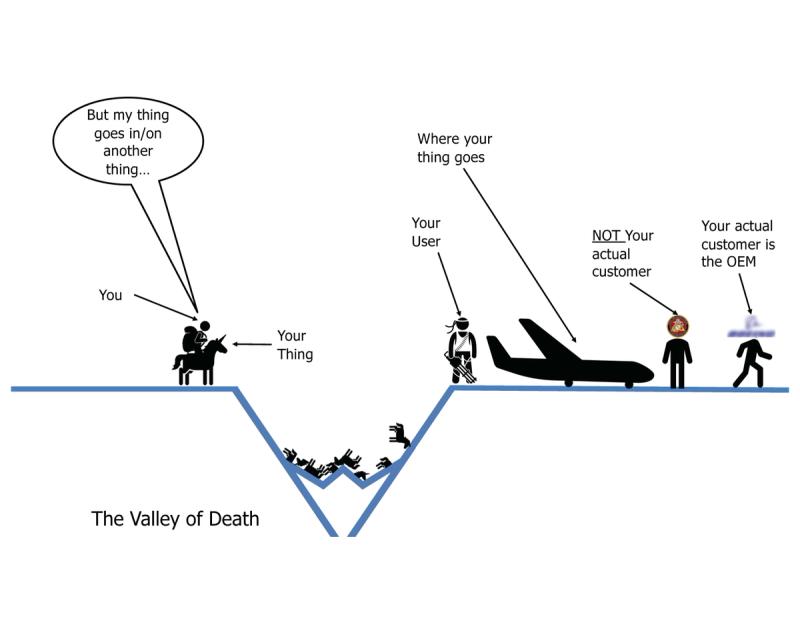
If your thing is an enhancement to a current system, then your customer is actually the Original Equipment Manufacturer (OEM). Now, if your thing literally bolts on, as in you bolt a radio into a Humvee or you put a standalone laptop on a bridge, then this typically does not apply. But if you plan to ENHANCE a current capability/system with your thing, so that it does IT'S thing better, then you have to sell to the OEM.
Why? because that how the system works. THAT company is on contact to deliver their thing, according to a spec in a requirement. So you either have to
a. convince the program office to change their requirement and write YOUR thing into the spec AND THEN pay for the engineering AND the cost of your thing, or:
b. you have to convince the OEM that they really need your thing to fulfill the spec they already have, for some reason.
In either case, there's a fair economic disincentive for the OEM to use your thing, it's usually in their best interests (for reputation, profit margin, IP rights, etc) reasons to fill that spec with their thing, or the thing of someone they already have on contract.
So, you've been warned.
So let's get down to brass tacks, I'm here telling you that you need to go talk to PMs in program offices, right?
But guess what, they're not always easy to find.
SOME OF THEM:
- Put thier phone numbers in their email blocks
- Go to conferences
- Respond to emails
- Answer the phone when their local small business advocate calls them
- Host industry days
- Seek out meaningful conversations with industry

But not all of them.
Why?
BECASUE THESE PEOPLE ARE BUSY!
Also, you and 1,000 of your competitors are constantly calling, emailing, and trying to corner them at conferences. Have some empathy, these people have demanding jobs.
"But I have a catapult" you say, you got some whiz bang S&T money, your R&D PM bought down all the risk, you're TRL 9, they would be foolish not to take your stuff, it's practically free chicken.
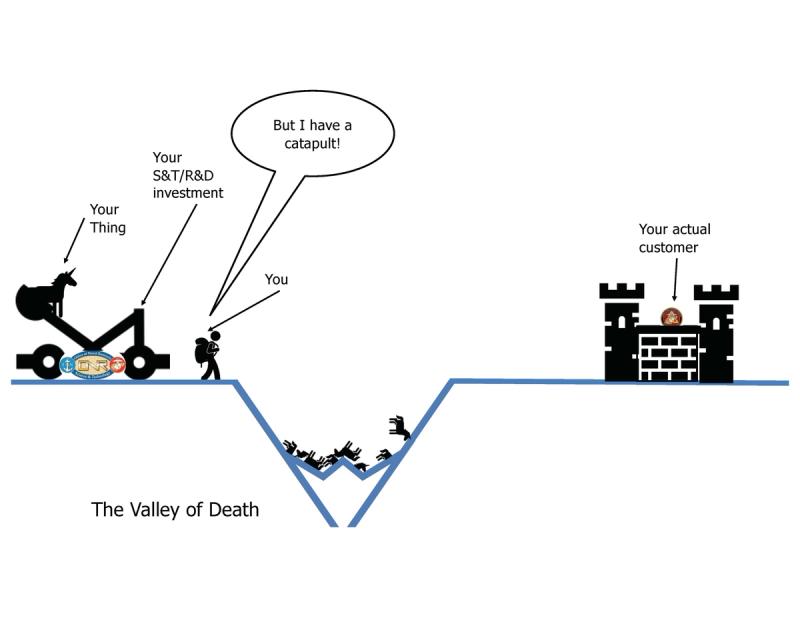
I love your energy, but lets talk about that...
Sign up for Rogue today!
Get started with Rogue and experience the best proposal writing tool in the industry.

